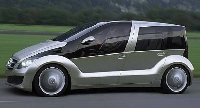A fuel cell uses the chemical reaction between hydrogen and oxygen to
generate electrical power in a process that produces no emissions. The
fuel cell in the Hygenius is around 40 percent more compact than
previously, runs more efficiently, and is notable for its good cold-start
characteristics, which has been achieved due to the inclusion of
innovations such as redesigned fuel stacks, an electric turbocharger, and
a new humidification and dehumidification system.
The fuel cell drive alone generates about 62 kW and torque of 250 Nm;
the rest comes from a lithium-ion battery that stores surplus power
generation in a fashion similar to that of a petrol/electric hybrid drive.
The electric motor draws power only from the battery at low speed, and
couples battery and fuel cell power when accelerating. Like other hybrids,
the electric motor doubles as a generator that charges the battery during
braking or while running downhill. As well as generating clean energy to
drive the research vehicle, the fuel cell can serve as a mobile power
source; its 66 kW of electrical power would be quite sufficient to keep
several houses supplied with power. All that is required is to connect the
device to a power socket in the tailgate.
"This represents a major step towards bringing the fuel cell drive up
to full production maturity, a goal that we aim to achieve some time
between 2012 and 2015," said DaimlerChrysler Board Member Thomas Weber.
"By developing the fuel cell, we are creating a new basis for supplying
energy in tomorrow's vehicles, which will make a further lasting
improvement to their environmental compatibility."
On the Web (links open in a new window):
DaimlerChrysler AG

Contents ©2005, Darnell Group, Inc. All
rights reserved.
